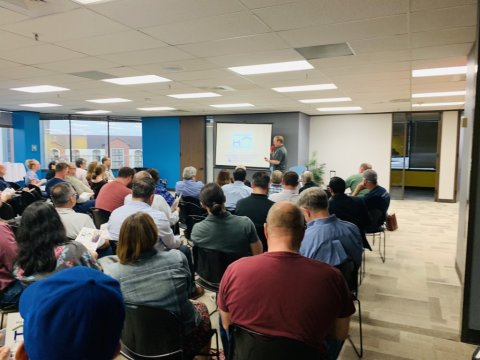Turn Your House Into a Rental

Before we get started with this week’s post, I’d like to thank everyone who was able to make it out to the Alamo REIA event. It was a great turnout. There are some new subscribers so just to catch you up, we’re just starting a series about different ways to get started in this business. On the main blog page, I suggest you read from the bottom to the top to stay in order with the steps of the BRRRR process etc. If you like what you are reading, please fill out the subscribe page so you don’t miss any content and share this with others who could benefit from this information. Welcome all and here is the latest post on Turning Your House Into a Rental!
Move and Turn Your House Into a Rental
This is the first of a series of posts on ways to get started investing in real estate. This first one is how we got started. We moved and turned our old house into a rental.
This may seem preposterous to propose but it may work if you have a house that fits the traits of a good rental. Now if you live in a 300,000 dollar house, this probably isn’t the move for you because your house is probably not a great rental house due to the higher value and taxes associated. These houses tend to appreciate more than lower-priced homes and thus may be a better one to consider refinancing, or even selling, for some cash to invest. But that is for another post. Right now we are focusing on the person who wants to turn their house into a rental.
This is the method we used to try our hand at investing so we’re pretty fond of it but be careful because you may get hooked and find yourself writing a blog on the topic at 5am one morning in a couple of years.
Now that you’ve moved out, you can go buy a new home with a low down payment or perhaps even rent your new home. Rent?!?! Yes, renting can be a good strategy for some people. Especially in higher priced areas. One of the most prolific real estate podcasters that I listen to, Jason Hartman, owns a lot of rental property but he still rents his luxury personal residences. But if you do buy again you may be able to get a lower down-payment type of loan because this new home will be owner occupied. Check with your lender. The rates are always better on owner-occupied type loans versus investment property loans. Often as much as 1 percentage point lower on the rate. This means that your loan on your first house is likely much lower than it would be for other investors, like me, who are buying houses strictly as investment properties. That gives a nice advantage to those getting started. Now if you can get the lower rate on house number two then you are starting to really take advantage of these rules.
If you want to amplify this effect even more, find a duplex, triplex, or fourplex to buy. Loans on properties up to four units are generally treated the same way as single family homes in regards to the types of loans available. Over five and you won’t get these great loan terms. So if I started over again, I’d try to find a multi-unit and put a minimum down payment and rent out the other units. Then, after a year, I’d move out and rent my unit out too. I know that many of us are rooted in our homes and this may not be the method we choose but it is an option for some who are hungry enough.
But what if you don’t have a house?
Well you have a unique opportunity to buy a home in a good rental area and use less cash to acquire the home because you are willing to live there. This is because owner occupants get better terms than investors. Now you will need to live in the house or else it will be mortgage fraud. But you could bring in a roommate or two to offset your living expenses and allow you to save for house number two! This is often referred to as “house hacking”. This might allow you to even live for free and redirect all of your would-be rental/mortgage payments to a fund for investing. Just because you got owner-occupant financing, it doesn’t mean that you can’t move later and keep this loan in place. The time required is not clearly stated, that I am aware of, but the often-mentioned time requirement is about a year before moving. This seems to be enough to show that your intent was to actually live in the house. Check with your lender on the rules. Can you see how fast this could begin building momentum? Maybe you even live close to a University and rent your house by the room to students when you move out. Usually sub-dividing can allow for a higher overall rent. Or you turn it into a short-term rental like Air BnB. Now this will require more work and paying to furnish it but it can be a way to get more money out of a property. Some areas are becoming saturated with STRs (short term rentals) so do your research. This isn’t my area of expertise so seek advice from some of the many people exploring this growing trend.
Some of the great things about starting with a house you have lived in is that you know the house well. You’ve probably worked through some of the kinks and problems. If you house-hack, you’ll be close by to address any issues that do arise. And after all, you have to live somewhere.
Why Not Expensive Homes?
In regards to the higher-priced homes you may live in already, the reasons I suggest that they may not make the best rentals are the following. One is that the taxes are probably higher and the house is likely larger which leads to more expensive upkeep. You likely have HOA dues and rents are probably much less that one percent of the value of the home. There are several metrics and thumb rules to apply to investment property but one is what is known as the 1 percent rule. If you can accomplish rental rates of approximately 1 percent of the purchase price or ARV (after repaired value) you might be in the ballpark of an investment you should look into further. There is much more to consider but this is just one quick metric. Generally, the lower priced properties will be easier to get to 1% or maybe even 2%! The issue with very low priced houses is that the management is usually much more intensive and actually collecting rents may not be as easy as you planned. However in the luxury home market, you may only be at 0.4%. In other words, the rents don’t increase in correlation to the prices and taxes. This is why Jason Hartman rents his luxury homes.
Another reason I don’t prefer the higher priced homes as rentals, and why we sold the first rental we had, was that the tenants were great but were transitional. Most of them stayed a year and left the house in great shape but they had the means to buy or build and our house was just a transitional place for them. This led to frequent vacancies. The house always rented quickly but vacancies always cost money and we prefer long-term tenants. On the other hand, our houses worth just over 100K or so (with no HOA), have very long-term tenants in general. We love this. Most of these tenants don’t envision owning and they are happy to rent from a responsive, kind landlord. This is just based on our experience and others are successful in the higher and lower priced markets so take it with a grain of salt.
So to re-cap, you can buy a house to make into a rental when you move out. You can move out of your home and turn it into a rental. You can move into a multi-unit property and rent the other units out. For the rental you could do student housing, Air BnB, traditional long-term rentals, or even some of the more complex strategies such as the group home or independent living models. You could also do a “live-in flip” with any of these stages where you improve the home while living there and re-sell for a profit. If you live there 2 of the previous five years, you can be exempt from capital gains taxes on the profits!
As you can see, many of these methods can be combined to get the ball rolling. I will be outlining several other methods for getting started over the coming weeks. I hope to show everyone who has read this far a method to get started that they can make work for them and some of the strengths and weaknesses of each strategy. Let me know if you have any questions regarding these techniques and I will do my best to clarify.
Getting the first deal is the hardest one and that is why I am showing so many ways to get there. Some of these methods can be used for subsequent projects after number one as well. You have to believe in this plan and have a positive mindset in this, or anything, to be successful. Being a little bit hungry doesn’t hurt either. If you want it bad enough, you can change your entire future and have freedom to do what matters most to you. And this will allow you to “keep the main thing the main thing!”
